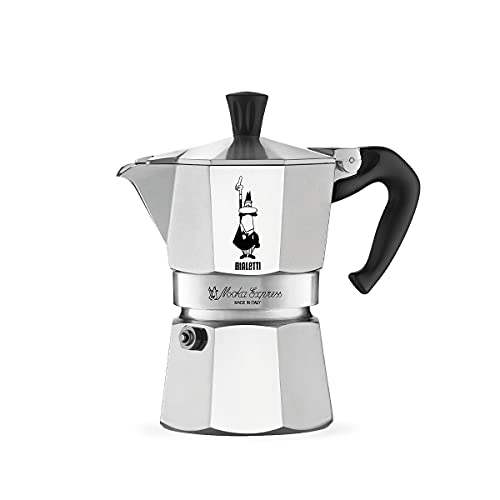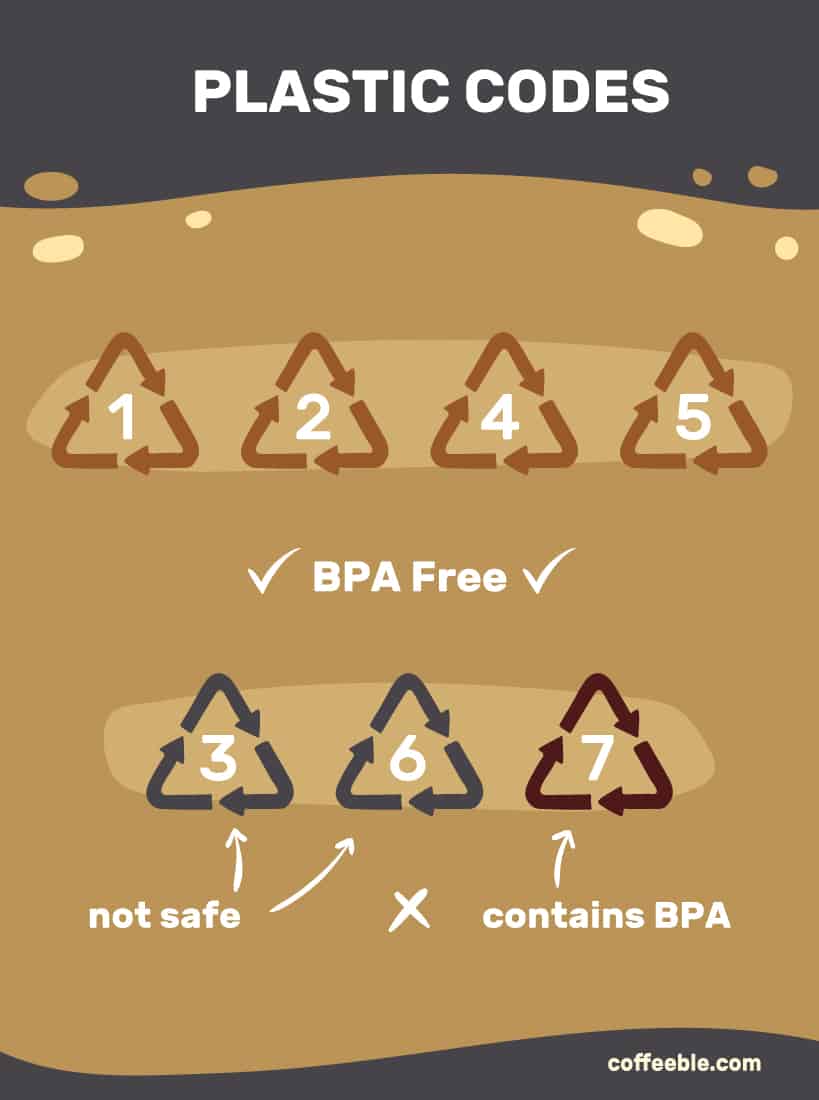Cuisinart Grind & Brew DGB-550BKP1
The Best BPA Free Coffee Makers in 2024
| product | detail | Button | |
|---|---|---|---|
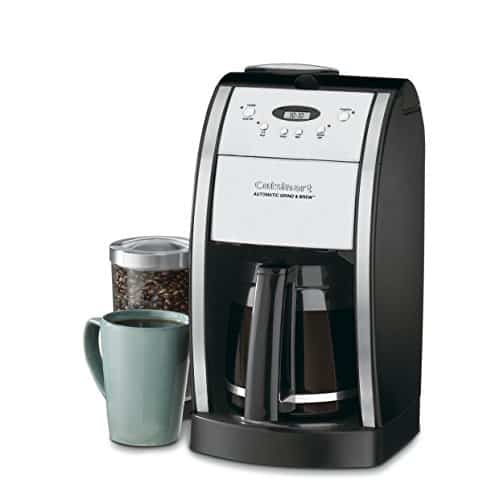
|
Cuisinart Grind & Brew DGB-550BKP1 |
|
 SEE ON AMAZON
SEE ON AMAZON
|
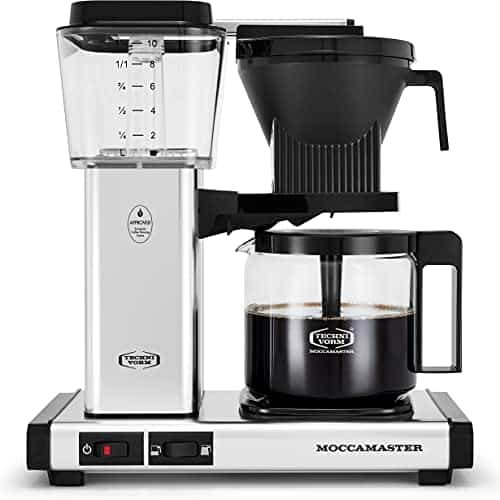
|
Technivorm Moccamaster KBGV Select |
|
 SEE ON AMAZON
SEE ON AMAZON
|
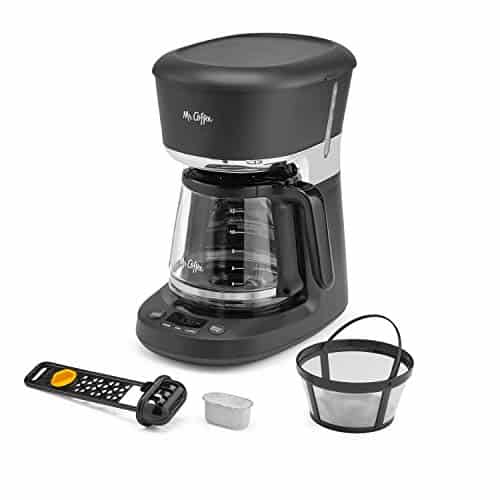
|
Mr. Coffee 12 Cup Dishwashable Coffee Maker |
|
 SEE ON AMAZON
SEE ON AMAZON
|
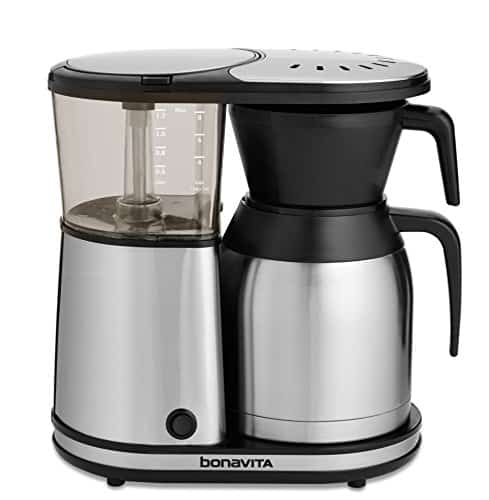
|
Bonavita Connoisseur 1901TS |
|
 SEE ON AMAZON
SEE ON AMAZON
|
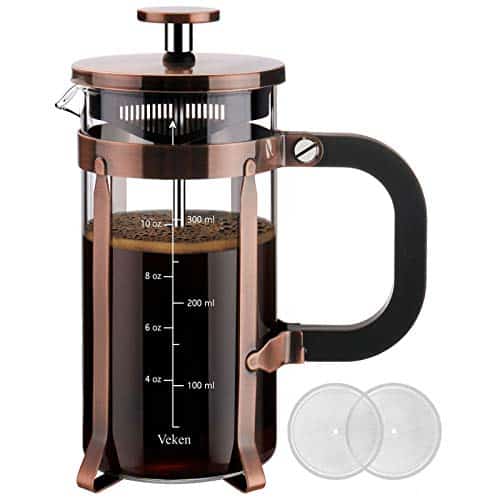
|
Veken French Press |
|
 SEE ON AMAZON
SEE ON AMAZON
|
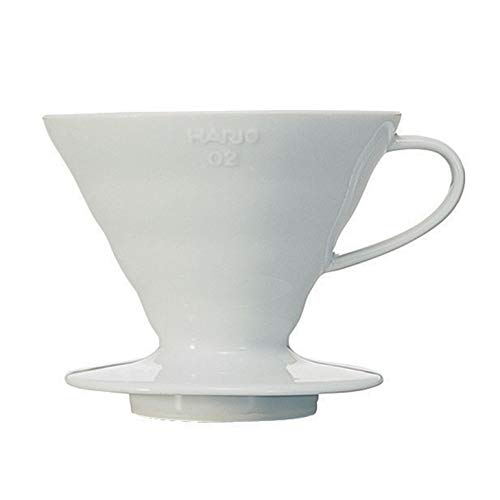
|
Hario V60 Ceramic Coffee Dripper |
|
 SEE ON AMAZON
SEE ON AMAZON
|
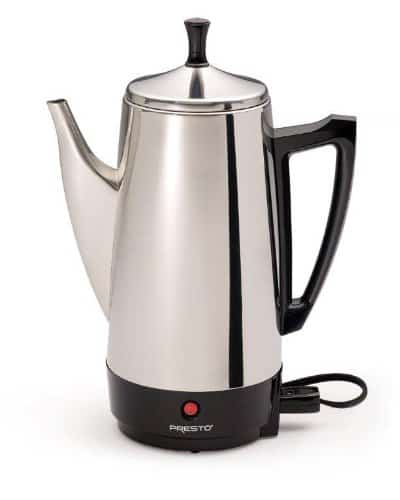
|
Presto 12-Cup Stainless Steel Coffee Maker |
|
 SEE ON AMAZON
SEE ON AMAZON
|
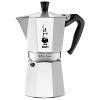
|
Bialetti Express Moka Pot |
|
 SEE ON AMAZON
SEE ON AMAZON
|
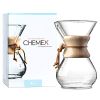
|
Chemex |
|
 SEE ON AMAZON
SEE ON AMAZON
|

- 7.5 x 11.2 x 15.2 inches
- Stainless steel, glass, BPA free plastic
- Drip brewer

- 14 x 12.75 x 6.5 inches
- Stainless steel, glass, BPA free plastic
- Drip brewer

- 13.8 x 9.3 x 14.4 inches
- Glass, BPA free plastic
- Drip brewer

- 12.4 x 6.8 x 12.2 inches
- Stainless steel, BPA free plastic
- Drip brewer

- 8 x 5.2 x 5.2 inches (12 oz size)
- Stainless steel, glass, BPA free plastic
- French press

- No dimensions
- Ceramic
- Pour over

- 13.1 x 9.7 x 6.2 inches
- Stainless steel, plastic
- Percolator

- 4 x 5.6 x 6.7 inches (3 cup size)
- Material: Aluminum
- Moka pot

- 5.1 x 5.1 x 8.5 inches (6 cup size)
- Glass, wood
- Pour over
The buzz around BPA-free products isn’t as high as a decade ago when the public first raised the concerns. Many manufacturers have now stopped advertising their products as BPA-free, instead highlighting other features of their machines. We’ve done careful research to ensure that all of these brands make for the best BPA-free coffee maker.
You’ll see that we’ve also labeled all of the materials used in the machines, even if they don’t come into contact with your coffee, so that you can buy an utterly plastic-free coffee maker if you desire.
1. Cuisinart Grind & Brew DGB-550BKP1 – Best Overall
Specifications
Dimensions: 7.5 x 11.2 x 15.2 inches
- Material: Stainless steel, glass, BPA free plastic
- Type of brewer: Drip
- Capacity: 60 oz
Convenience is one of the biggest draws of having a drip coffee maker. Getting a fresh coffee each day can be as simple as filling up the machine and pressing start. Of course, this easy brewing assumes that you’re using pre-ground coffee, which isn’t doing justice to your drink.
The Cuisinart Grind & Brew combines quality and convenience with a built-in grinder. The grinding chamber holds the right amount for a whole pot of coffee and automatically dispenses the beans into the filter basket after grinding. There’s also a grinder-off feature if you want to use your ground coffee. The one downside here is that the grinder isn’t adjustable.
The Cuisinart 550 has plenty of features for ease and use and better coffee on the brewing end of things. It features a showerhead for even water distribution, a 1-4 cup brew size setting, a Brew Pause feature to let you pour a single cup and a programmable start up to 24 hours in advance.
There are some plastic parts with the grinder, the water reservoir, and the filter basket. The good news is that they’re all BPA-free. Cuisinart assures us that any products that come into contact with either food or water are entirely free of BPA plastics.
2. Technivorm Moccamaster KBGV Select – Best High End
Specifications
Dimensions: 14 x 12.75 x 6.5 inches
- Material: Stainless steel, glass, BPA free plastic
- Type of brewer: Drip
- Capacity: 40 oz
You’ve probably heard us sing the praises of the Technivorm more than once, and in fact, the brand came out on top one our list of SCA-certified coffee makers. These machines are a lot more expensive than your average drip coffee maker, but the quality of both the coffee and the equipment is undeniable.
At first glance, you might wonder what all the fuss is here, with no options to adjust your brew. But rest assured, the Moccamaster KBGV Select has been engineered to create excellent coffee every time. The unique copper heating element provides consistent brewing temperatures, and the pulse style brewing helps to replicate a pour-over style coffee. You have the option of choosing a half or full carafe without losing any brew quality.
The plastic used in Moccamaster machines is BPA-free and free of BPS, BPF, and phthalates. The brand also considers how sustainable its machines are, using recyclable packaging, recyclable parts and ensuring that replacement parts are available even for discontinued machines. In addition, your Moccamaster will be backed by a 5-year warranty.
3. Mr. Coffee 12 Cup Dishwashable Coffee Maker – Best Value for Money
Specifications
Dimensions: 13.8 x 9.3 x 14.4 inches
- Material: Glass, BPA free plastic
- Type of brewer: Drip
- Capacity: 60 oz
Keeping your food free of toxins should be a luxury, and this Mr. Coffee machine proves that you can go BPA-free on a budget. The brand offers even cheaper models than this, all of which are BPA-free, but a few features of this model caught our eye.
A quick-release catch means you can disassemble the coffee maker without any tools, and the carafe, water reservoir, lid, and brew basket can all go in the dishwasher. This isn’t the same as descaling, but it will help you keep your coffee maker free of coffee residue, which can impact the taste of your coffee and the performance of your machine.
When making coffee, you can opt to “brew now” or “brew later”. The Mr.Coffee machine will let you program a start time up to 24 hours in advance. After the brewing cycle, the coffee maker will switch to keep warm mode for the next four hours, after which it will shut off automatically. If you can’t wait for a full carafe to brew, there’s also a Grab-A-Cup feature that lets you sneak a single cup of coffee mid-brew.
4. Bonavita Connoisseur 1901TS – Best Thermal Carafe
Specifications
Dimensions: 12.4 x 6.8 x 12.2 inches
- Material: Stainless steel, BPA free plastic
- Type of brewer: Drip
- Capacity: 44 oz
With a thermal carafe, you have to be particularly careful about the quality of the machine that you buy. The stainless steel construction gives these carafes their ability to keep coffee hot, but the interior is often plastic. Yes, the part that spends the most time in direct contact with your coffee. Thankfully, all of the plastic components on all Bonavita coffee makers are BPA-free.
You might want to avoid plastic altogether, but this thermal carafe is worth considering. Most coffee makers with thermal carafe claim to keep coffee warm for up to an hour after brewing, but the Bonavita Connoisseur will go three and a half hours before dropping to below 150 F (1).
Brewing is a simple one-touch operation, with a full carafe ready in around 6 minutes. If you’ve got a little extra time, there’s an optional preinfusion cycle that will bloom your coffee grounds for an even better flavor.
The Connoisseur is an upgrade on a previous model – the regular 1901TS. For the most part, they’re the same, but this one features a hanging filter basket, which is said to help with more even extraction. You should also be aware that this little number is SCA certified, making it a pretty incredible value for money.
5. Veken French Press – Best French Press
Specifications
Dimensions: 8 x 5.2 x 5.2 inches (12 oz size)
- Material: Stainless steel, glass, BPA free plastic
- Type of brewer: French press
- Capacity: 12 oz – 34 oz
A French press is an excellent choice for anyone who wants to avoid a lot of plastic in their coffee maker. These brewers are usually glass with a stainless steel frame or full stainless steel construction. You will need to keep an eye out for small plastic elements, especially around the lid and the plunger (the handle won’t come into contact with your coffee).
The Veken French press includes a plastic grill under the lid, but this is 100% BPA-free and has limited contact with your coffee. The carafe is borosilicate glass, and the plunger and filter are made from food-grade 304 stainless steel (2). The frame is also stainless steel but comes in four finishes: copper, black, silver, and stainless steel.
With a double mesh filter, elegant design, and choice of three sizes, it’s easy to see this is one of Amazon’s best-selling French presses.
6. Hario V60 Ceramic Coffee Dripper – Most Portable
Specifications
Dimensions:
- Material: Ceramic
- Type of brewer: Pour over
- Capacity: 10 oz
If your journey to BPA-free brewing includes ditching the automatic coffeemaker, then you might as well enjoy the opportunity to get something you can take on the road. The Hario V60 is a favorite among the manual brewing methods, both for its compact design and its coffee.
If you’re a first-time pour-over user, you’ll need to learn the technique, as well as get a bit of gear. With a decent grinder and a gooseneck kettle, you’ll be good to go, but for expert elver brewing, you might want a thermometer and a digital scale too.
The payoff comes in the control you have over the brew, which you’ll discover directly affects the quality of your final cup. The ability to change your brewing variables will be vital if you want to try different beans (which you absolutely should).
The classic V60 is this ceramic model here, but Hario does make plastic models as well. The upside to plastic here is lighter, cheaper, and possibly less likely to break. The plastic models are BPA-free, but with ceramic on offer, you can avoid plastic altogether.
7. Presto 12-Cup Stainless Steel Coffee Maker – Budget Pick
Specifications
Dimensions: 13.1 x 9.7 x 6.2 inches
- Material: Stainless steel, plastic
- Type of brewer: Percolator
- Capacity: 60 oz
For anyone used to an automatic coffee maker, the Presto will be the easiest transition – there aren’t even any brewing options to worry about. Electric percolators require the same steps: fill the brew basket, add the water, and press start. After brewing, the Presto will switch itself to keep-warm mode.The difference here is in the brewing method. While coffee makers work by dripping water slowly through coffee grounds a single time, a percolator will pass water through the grounds multiple times. The water temperature also differs. Percolators work using the pressure formed by boiling water, whereas drip coffee makers should brew between 195 to 205 F (3).
You’ll see that the base and handle are made from durable plastic, but neither of these parts will come into contact with your coffee at any time. The machine itself, including the perk tube and filter basket, is made from food-grade stainless steel.
8. Bialetti Express Moka Pot – Best Stovetop
Specifications
Dimensions: 4 x 5.6 x 6.7 inches (3 cup size)
- Material: Aluminium, plastic
- Type of brewer: Moka pot
- Capacity: 2 oz – 27 oz (1 – 18 cups)
You’d be forgiven for thinking that the Moka pot is the same as a percolator, but there are a couple of differences. A Moka pot only passes water through the grounds once, and there’s no automation – it requires a separate heat source. Brewing still only requires you to add the coffee and water and place it on the heat, but you’ll need to keep an eye on it and remove it as soon as the coffee is ready.
Apart from the plastic handle and the knob on the lid, everything here is made of metal. So there’s no need to worry about any BPA. However, rather than the stainless steel coffee makers found elsewhere, the Bialetti Express is aluminum.
Aluminum was once commonly used for cookware due to being lightweight, cheap, and a great heat conductor. Still, it isn’t as durable as stainless steel and isn’t suitable for induction stovetops (4).
Some coffee drinkers might have concerns about the safety of aluminum. Still, research has shown that even a daily brew from a Moka pot will only put you at 4% of your weekly recommended aluminum intake (5).
9. Chemex – Best Pour Over
Specifications
Dimensions: 5.1 x 5.1 x 8.5 inches (6 cup size)
- Material: Glass, wood
- Type of brewer: Pour over
- Capacity: 15 oz – 50 oz (3 – 10 cups)
You don’t need to take the brand’s word that Chemex is BPA-free. There is nowhere for plastic to hide – toxic or otherwise. The elegant construction has always been a drawcard for those who appreciate good design. Still, the fact that it’s only glass and wood makes it an excellent choice for anyone who prefers to buy renewable or recyclable materials.
The Chemex has the biggest learning curve and a hands-on brew time comparable with the Hario, of all the coffee makers on this list. With a pour over you always have more control over brewing variables than with an automatic machine. Such control allows you to tweak the process at any step of the way to land on your recipe for the perfect cup! But if you’re willing to put in the effort, you’ll be rewarded with a truly great cup of coffee.
The classic Chemex design has a glass carafe and wooden collar and is available in a range of sizes from 3 cups up to 10 cups. You’ll also find some different designs, including those with handles or meant for travel, but rest assured, these are all BPA free too.
How to Choose a Safe Coffee Maker
We’re not here to freak you out. We don’t want you to think that getting your caffeine fix is dangerous. But we must inform you about what’s going into your body when you make coffee at home.
The number one thing you can do is to avoid BPA. Due to its use in hard transparent plastics, such as your coffee machine’s water reservoir, you’re almost sure to encounter BPA in coffee makers if you don’t pay attention.
BPA is not the only problematic plastic, but it is the one you’re most likely to find in appliances. Other toxic plastics include polyvinyl chloride (indicated by the “3” symbol), which is found in food containers, and polystyrene (7 symbol), which you’ll know from foam coffee cups.
If you want to be safe, the best thing you can do is avoid plastics altogether. Some people also choose to avoid buying plastic due to environmental concerns. Plastics can take up to 450 years to break down (6). That’s a lot of landfill space taken up with broken coffee makers for the next few centuries.
Why do you need a BPA-free coffee maker?
You’ve probably heard about BPA-free plastics when it comes to baby bottles or travel mugs, but it can apply to coffee makers as well. BPA or Bisphenol A is often added to plastics to make them harder, particularly when it comes to transparent plastic. Its discovery in the 1950s was a revelation for the manufacturing industry, as products could now be made lighter, more durable, and at a lower price. It wasn’t until many decades later that the long-term effects of exposure to BPA became apparent, and it wasn’t good news.
Before you observe that there won’t be any infants or children drinking from your coffee maker, there are health concerns for adults too. BPA has been shown to play a role in fertility problems for men and women, breast and prostate cancers, and metabolic disorders, including polycystic ovary syndrome (PCOS) (7).
The FDA has released research stating that BPA is safe for use in food applications (8), but with plenty of studies that prove otherwise, it’s probably better to avoid this plastic when you can. Coffee is great, but not worth getting sick over.
BPA Free Drip Coffee Makers
Plastics are pretty much impossible to avoid, especially when it comes to coffee machines. In coffee makers, the inner parts like the water tank or the coffee filter basket are made of plastic. These parts are in direct contact with the hot water and the coffee you drink, which could cause concern.
One of the issues with BPA is that it doesn’t stay put. You might think that the plastic container you’re using is water-tight, but on a chemical level, it’s not. BPA is soluble when exposed to heat or water, which is awful news for any vessel that’s meant to be holding hot coffee.
When shopping for the best coffee makers, ensure that the manufacturer mentions explicitly that they use BPA-free plastics. If they don’t, you can assume that BPA is used.
Plastic Free Coffee Makers
The easiest way to avoid having any BPA plastic come in contact with your coffee is to buy a plastic-free coffee maker. Sadly, this means that the classic drip brewer is off the cards, but look on the bright side – it’s an opportunity to try out some new brewing methods.
Most French Press coffee makers are made of glass. But some exterior parts and the plunger (which comes in contact with hot water) could be made of plastic. Often, those parts are BPA-free, but if you want to avoid plastic altogether, choose stainless steel or ceramic french press.
Most percolators are BPA-free coffee makers as they are made of stainless steel. The only plastic parts may be the knob on the lid or the handle, neither of which will come into contact with your coffee.
If you’re going plastic-free for environmental reasons, your best bet is a pour-over brewer. The way that these coffee makers are designed means there’s no need for any plastic parts so that you can find all-metal, all-ceramic, or all-glass coffee makers.
What we haven’t included here are espresso machines. Most electric pump espresso machines will use plastic in the reservoir at least, but if you’re willing to put in the extra work for the brewing, you can find some genuinely plastic-free manual lever espresso machines.
Other things to consider when buying toxic-free coffee makers
The materials used in a coffee maker will be the first thing to consider when buying a BPA free coffee maker. But at the end of the day, you still want a brewer that meets your needs and your budget.
If you’ve decided to switch from automatic drip to manual coffee brewing methods, you’ll need to consider not only the learning curve that might be involved but the different style of coffee you’ll be making. Pour over is probably the closest in terms of the taste of the coffee. But it does require the most amount of work. There’s no set and forget here! On the bright side, pour-over coffee makers are often easy to clean.
French presses and electric percolators have a relatively hands-off brewing process, but they make a coffee with a much fuller body. If you’re not used to it, you might find the richness and brew-strength of French press coffee offputting, but it’s one of the things that people love about it.
The Verdict
We can safely say that all of the coffee makers on this list are free from BPA or plastic, so you can’t go wrong here if you’re looking for a safe way to brew coffee. But if you want to stick with traditional coffee makers, we think the best BPA-free coffee maker is the Cuisinart Grind & Brew. The built-in grinder gives you better-tasting coffee with a minimum of fuss, and the programmable features mean the machine can grind and brew before you’ve even considered getting out of bed.

FAQs
Plastic coffee makers are safe provided that they use the right type of plastic. Plastic components that come into contact with your coffee should always be food grade. You should also avoid any plastics that contain polyvinyl chloride, polystyrene, and BPA. These plastics are represented by the numbers 3, 6, and 7 on the recycling symbol.
Hamilton Beach may make a BPA-free coffee maker, but its products are no longer advertised with this claim at the time of writing. Hamilton Beach has also removed all mention of BPA plastics from its website. If BPA-free plastic is non-negotiable on your shopping list, your best option is to contact Hamilton Beach directly.
The healthiest way to make coffee is to avoid adding too many extras such as sugar or creamer. Black unsweetened coffee is very low in calories and fats and contains vitamins, minerals, and antioxidants that can benefit your health. Filtered coffee is said to be healthier than unfiltered coffee (such as from a French press) as the coffee’s natural oils may raise your cholesterol levels.
Keurig coffee makers are BPA free, but we haven’t listed them here due to the large amounts of plastic used in the construction. K-Cups are also BPA-free, but again, they use a large amount of plastic.
- Bennett, B. (n.d.). Bonavita’s improved coffee maker is now its best. CNET Retrieved November 16, 2021, from https://www.cnet.com/reviews/bonavita-8-cup-connoisseur-brewer-review/
- Food grade stainless steel barrels: Drum it up! Drum It Up! | Steel Drum Industry News, Trends, and Issues. (2020, November 9). Retrieved November 16, 2021, from https://www.skolnik.com/blog/what-makes-food-grade-stainless-steel-safe
- How to brew coffee. NCA. (n.d.). Retrieved November 16, 2021, from https://www.ncausa.org/About-Coffee/How-to-Brew-Coffee
- Aluminum vs stainless steel cookware – whats better for you. Two Kitchen Junkies. (2020, January 11). Retrieved November 16, 2021, from https://www.twokitchenjunkies.com/aluminum-vs-stainless-steel-cookware/
- Cameron, S. (2020, October 9). Health risks of Aluminum Coffee Makers. Hunker. Retrieved November 16, 2021, from https://www.hunker.com/12003944/health-risks-of-aluminum-coffee-makers
- How long does it take for plastic to decompose? Chariot Energy. (2021, April 22). Retrieved November 17, 2021, from https://chariotenergy.com/blog/how-long-until-plastic-decomposes/
- Bisphenol A (BPA): Use in food contact application. U.S. Food and Drug Administration. (n.d.). Retrieved November 17, 2021, from https://www.fda.gov/food/food-additives-petitions/bisphenol-bpa-use-food-contact-application

Coffee expert and industry insider, I’ve dedicated years to mastering the art and science of coffee making. From scrutinizing particle fineness to evaluating burr shapes, I delve into the minutiae that elevate coffee from good to exceptional. Whether it’s a complex pour-over or a robust espresso, my insights cater to those who don’t just drink coffee, but experience it.







